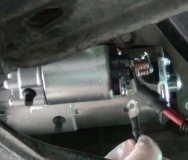That's normal operation but can vary slightly depending on the arrangement of the crankshaft position sensor and the camshaft position sensor. Typically the crankshaft position sensor tells the Engine Computer when a piston is coming up on top-dead-center, and the camshaft position sensor tells the computer which one is coming up on TDC on the compression stroke.
In addition to the camshaft position sensor, it is common to find the notches that are detected by the crankshaft position sensor have staggered numbers, meaning, for example, there might be four notches, then four notches, then three notches, with each group indicating a pair of pistons on a V-6 engine are coming to top-dead-center. When the injectors are "batch-fired", meaning three together on one circuit, it's enough to know engine rpm, then they get fired once per two crankshaft revolutions. When they're sequentially-fired, meaning fired individually, as with spark, they have to be timed appropriately for the event, and that is fine-tuned by the signals from the camshaft position sensor. The different number of notches for the crank sensor also tell the computer which pair of pistons are coming up on TDC. When all three groups of notches are identical, signals from the cam sensor are required for the computer to know what to do.
During cranking, the computer has to see enough signal pulses to know exactly which piston is coming up on TDC on the compression stroke. With many GM V-6 engines, that can take three crankshaft revolutions to learn. If you turn the ignition switch to "off", the computer has to go through that process again next time. Where this becomes interesting is for many years GM only needed both sensor signals for starting. Once the engine is running, if one sensor fails, the computer still knows when to fire the injectors and spark plugs by calculating the next ones in the physical order. It's not until you stop the engine that the computer won't be able to know which ones to fire first, so you'll have a crank / no-start condition.
There were also some GM V-6 engines that with a failed sensor, the computer would guess at which spark plugs to fire first, and it had a 33 percent chance of being right. If it guessed correctly, the engine would run in a back-up mode. If it guessed wrong, you'd have backfiring and popping. The important point here is when that happens, if you stop cranking but only let the ignition switch return to "run", the next cranking attempt would just continue the order of the calculations on which plugs to fire. You had to turn the ignition switch all the way to "off", then turn it back on and try cranking again, and then you'd have another 33 percent chance the computer would guess right and the engine would run.
All of this pertains to engines that use ignition coil packs with each coil firing two cylinders at the same time. This wasn't a concern when we had distributors because that is what physically sent the spark to the correct cylinder. All the ignition module had to do was figure out when to fire the coil. It didn't have to learn which cylinder to send it to. With coil packs, the computer needs cranking time and revolutions to learn when to fire the coils before it will turn on and do so. That's why you'll never have an electronically-fuel-injected engine start instantly like often occurred with carburetors and distributors. Early fuel-injected engines could also start instantly when they used throttle body injectors. Their pulses weren't timed to a specific cylinder so they started firing right away. Those engines used distributors too, so the computer didn't have to learn which cylinder to fire. It just started firing the ignition coil right away.
Thursday, January 2nd, 2020 AT 11:52 AM



